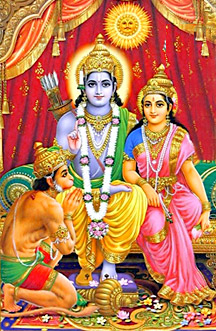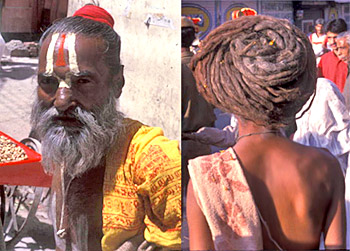 People belonging to Ramanandi Sampraday generally worship Lord Rama with Sita as their tutelary deity. They are called Ramanandis or Ramavats. Ramananda Sampraday was found by Ramananda. Their philosophical basis is same as that of the Ramanuji ascetic, that is, qualified dualism. The Ramanandis do not like to be grouped with Sri Sampradaya of the Ramanuji sect, which is the first and the oldest of the Sampradayas. According to Ramananda the school begins with Lord Rama and the doctrine descends through Sita and their devotee Lord Hanuman through a succession of twenty-two preceptors to Hariyananda.
People belonging to Ramanandi Sampraday generally worship Lord Rama with Sita as their tutelary deity. They are called Ramanandis or Ramavats. Ramananda Sampraday was found by Ramananda. Their philosophical basis is same as that of the Ramanuji ascetic, that is, qualified dualism. The Ramanandis do not like to be grouped with Sri Sampradaya of the Ramanuji sect, which is the first and the oldest of the Sampradayas. According to Ramananda the school begins with Lord Rama and the doctrine descends through Sita and their devotee Lord Hanuman through a succession of twenty-two preceptors to Hariyananda.
The Ramanandi Sampraday had three divisions. They are: (1) Asthanadhari, (2) Khalsa, and (3) Akhadamalia.
The Asthanadharis keep to one place and carry on their religious performances. The Khalsas mostly move about and propagate the religious doctrines of their sect. The Akhadamalias form the Nagas or fighting Bairagis. Akhada means a gymnastic centre and the Naga section of the Bairagis of Ramanandi sect constitute the athletes of Akhada organization. There are two divisions in the Akhada organization.
(1) Asthani Akhada or settled or sedentary Akhada and
(2) Ramat or migratory Akhada or Akhada on the move.
The Akhadamalia Section of the Ramanandi Bairagis is divided into three army (Ani) groups: (1) Digambar Ani (skyclad Army), (2) Nirmohi Ani (Army devoid of any Moha and Maya) and (3) Nirvani Ani (Army devoid of any sensual desire). Each of this army has its own Akhadas. The Digambara Ani comprises three Akhadas:
(1) Ram Digambara, (2) Syama Digambara and (3) Dhuriya Digambara.
The Nirmohi Ani has also three Akhadas.
(1) Nirmohi Akhada, (2) Santosi Akhada (3) Mahanirvani Akhada.
The Nirvani Ani consists of three Akhadas:
(1) Nirvani Akhada
(2) Niralambi Akhada
(3) Tatambari Akhada
 Besides these Akhadas the Ramanandi Bairagis have another typical Akhada called Khaki, the members of which feel happiness in contemplation of Brahma like their counterparts belonging to Ramanandi Niralambi Akhada.
Besides these Akhadas the Ramanandi Bairagis have another typical Akhada called Khaki, the members of which feel happiness in contemplation of Brahma like their counterparts belonging to Ramanandi Niralambi Akhada.
Among the Ramanandi Bairagis, whose supreme deity is Sri Ramachandra who is worshipped through the medium of Hanuman or Mahavir, the rule is that the Mahanta of Asthanadhari section is entitled to initiate an ascetic disciple. The initiation of a novitiate includes bestowal of a name, necklace, sect-mark, representative stamp and sacred formula. The representative stamp comprises a mudra of bow and arrow which Ram used to carry always with him. This mudra has to be permanently branded on the body. The necklace is single stranded containing 108 Tulasi-beads to be worn close to the neck. The sect marks are of three types: (1) two white vertical lines (Urdhapundra) with a red vertical one midway between them (Siri) which is worn by Asthandhari section, (2) two yellow vertical lines (Urdhapundra) with a red vertical one midway between them (Siri) which is marked by Naga section, and (3) two white vertical line (Urdhapundra) with a white vertical lines (Urdhapundra) with a white dot in between which is used by the Khalsa section of Ramanandi Bairagis. There are several monasteries of Ramanandi sect and some of its important branches in Puri. Of all these monasteries the Bada chhata matha is most important.
Other Ramanandi mathas which are located at Puri are Sana Chhata, Papudia and Neula Das mathas which perform such ritual services as whisk service (Chamara Seba), offering fruits just before sleep (Pahuda manohi seba) respectively at the temple. The Papudia which is otherwise known as pipalaya matha is the oldest of all Ramanandi mathas.
There are seven types of akhadas under Ramanandi sect. These akhadas are under the control of a Panch. Of all the akhadas the Bada akhada matha is most important and it is the main monastic organization of Ramanandi sect with full responsibility for taking defensive measures to resist invasion.




















